There are more things in life than just widescreen! | Read more at in70mm.com The 70mm Newsletter |
| Written by: Wolfram Hannemann, MBKS, | Date: 07.06.2010 |
 Town
Hall, Bradford. Image
by Wolfram Hannemann Town
Hall, Bradford. Image
by Wolfram HannemannThe first thing you’ll notice about Bradford when descending the coach at the central bus station is the smell of exquisite Indian spices, while you’re on your way to the Midland hotel. Being a big fan of Indian cuisine since my visits to London in the 80s, this lovely smell always promises me another big thrill while in Bradford, apart from the Widescreen Weekend. Well, at least the latter mentioned event is the reason why I am willing to travel from my home town in Southern Germany to the far North of England - the end of the world, as it sometimes seems to me. The Widescreen Weekend has become one of the regular attractions within the Bradford International Film Festival (BIFF) and 2010 marked its 15th year already (although this was BIFF #16). 2010 also marked the first time that the Widescreen Weekend had to relocate to another auditorium for the Sunday evening event. This was due to the fact that BIFF was shortened from sixteen days to just eleven, leaving the Closing Night gala of the film festival in Pictureville Cinema on Sunday evening. | More in 70mm reading: Wolfram Hannemann's 70mm Film Introductions John Harvey "Mr. Cinerama" in Bradford Speech for John Harvey Cinerama Showcase Internet link: wolframhannemann.de laserhotline.de |
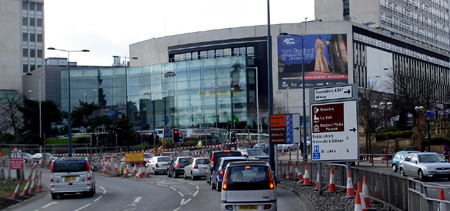 NMM. Image
by Wolfram Hannemann NMM. Image
by Wolfram HannemannThe Widescreen Weekend 2010 – as far as I can judge – became one of the most emotional ever. It started off on Friday morning with the traditional screening of „This is Cinerama!“ in the original 3-strip process. As a surprise guest the organizers presented one of the editors who worked on that film, Jim Morrison. It was his first visit to England in many years and I think if his daughter had not married a Yorkshire man, we probably would not have had the pleasure of meeting him. Before the start of the film Duncan McGregor introduced the audience to Jim and asked him to say some words on his experience whilst editing „This is Cinerama!“ After only a few sentences Jim obviously was so overwhelmed by his memories that he couldn’t stop tears from running down his face and all of a sudden stopped his speech saying “Come on – let’s get this thing started!” and dropped off the stage. I thought that this must have been one of the most emotional moments I have ever encountered since attending the festival. Luckily, Jim returned to the microphone during the film’s intermission and told some interesting facts about his work. | |
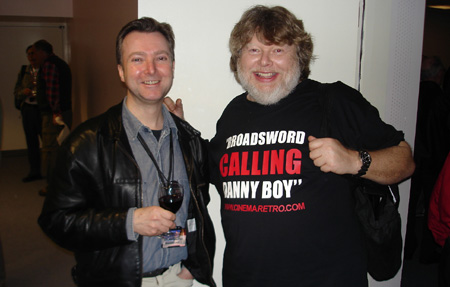 Sheldon
Hall and Dave Worrall Image by Wolfram Hannemann Sheldon
Hall and Dave Worrall Image by Wolfram HannemannThe other really moving moment during the Widescreen Weekend was John Harvey’s appearance. John must be regarded as the driving force behind all Cinerama installations in the past 20 years and he was deeply involved in the Pictureville installation. Unfortunately John had a stroke some years ago and now, often requires the assistance of a wheelchair to get about. It was his first visit to Bradford since helping install the Cinerama screen back in 1993 and thanks to sponsor and Cinerama afficionado Tom March from Canada, everything necessary was arranged to make John‘s stay as comfortable as possible. In a screentalk with Larry Smith, John’s buddy for many many years, the audience was invited to learn about John’s enthusiasm for Cinerama, his kindness in helping cinemas to re-install the system and his support in bringing this breath-taking process to next generation audiences. In addition to the screen talk, John Harvey finally got his long overdue entry into the “Widescreen Academy”. Well done John! OK – let’s now plunge into the movies which I picked to see during that fantastic weekend. | |
„This is Cinerama!“ (3-strip Cinerama, 7-track magnetic stereo sound) | |
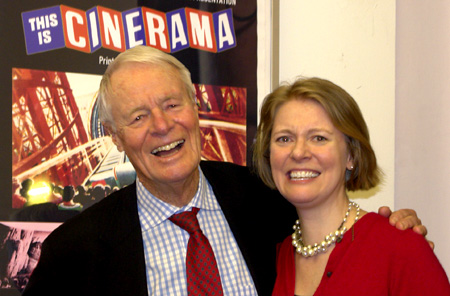 Jim
Morrison with his daughter. Image
by Tom March Jim
Morrison with his daughter. Image
by Tom MarchThe more I see this classic the better it gets! My stomach still feels very strange once the 3-strip camera takes us on that rollercoaster ride. You should know that I only once went onto a real rollercoaster – and hated it! So seeing it from the safe position of my reserved seat in Pictureville’s auditorium probably gives me the thrill I am missing on rollercoasters in real life! While I decided on last year’s visit to Widescreen Weekend only to sit through the first part of the film, this year I gave it the full treatment and watched it through until the very end – and that is when the exit music finishes. | |
„Manhattan“ (35mm, Scope 1:2.35, Mono optical sound) | |
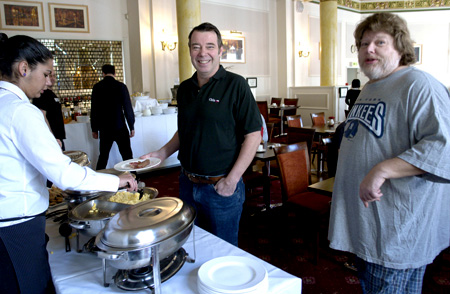 Lee
Pfeiffer and Dave Worrall. Image
by Tom March Lee
Pfeiffer and Dave Worrall. Image
by Tom MarchIt felt somewhat strange to see a classic Woody Allen movie in the weekend’s schedule. However since this was Woody’s first (but not last) film in the 2.35:1 ratio, it was okay to have it as part of Widescreen Weekend. Duncan did a nice introduction to it, revealing that this is one of his favourite movies. The perfectly framed black and white pictures by Gordon Willis and the music of George Gershwin set against the background of New York, make this comedy very enjoyable. And of course there is this gorgeous cast led by Woody Allen: Mariel Hemingway, Meryl Streep and Diane Keaton. I soon realized how young they were back in 1979 when the picture was shot! The 35mm print we were watching was young, too. According to Duncan it was only two years old. So I guess that it is due to bad printing that the blacks weren’t really black, but looked more like a very dark grey. Too bad that such prints are allowed to be screened commercially! | |
„Battle of the Bulge“ (70mm, Rectified Ultra Panavision print, 6-track magnetic stereo sound, Swedish subtitles, presented on the curved screen) | |
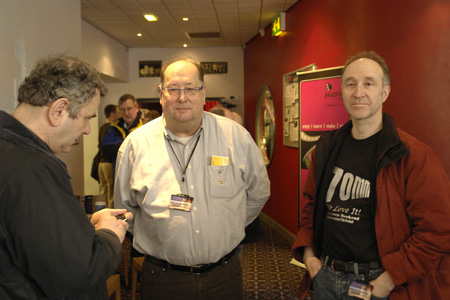 Mark
Lyndon, Francois Carrin and Wolfram Hannemann. Image
by Tom March Mark
Lyndon, Francois Carrin and Wolfram Hannemann. Image
by Tom MarchThis WWII film from the point of view of Cinerama Inc. came in a quite good 70mm print from the Swedish film archive. The colours were a bit faded, but still there. It was an optically corrected print to be shown on deep curved screens, i.e. the left and right edges were squeezed anamorphically, whereas the centre of the frame was not squeezed. However, it was shown in Pictureville cinema using an anamorphic lens, which resulted in the edges being undistorted and the centre being just a bit too stretched. In addition, the usage of the anamorphic lens did give us a picture which was a bit too dark. Anyway I enjoyed the show, although I must admit that I regard this movie as being trashy – and I love trash! There are two sequences in the film which try to copy the famous rollercoaster ride from „This is Cinerama!“. They certainly do not belong in a movie about WWII! Another thing I like about the film is another very funny fact... at least if you are able to understand German. During one scene American soldiers are shooting their way out of an ambush by the Nazis. In the film you clearly can here the German dialogue “Der Schuss kam von da oben!” which would translate to “The shot came from up there!”. The very same dialogue can be heard throughout the film as soon as German soldiers are seen on screen. Of course this sentence makes no sense at all in these other places, where it is used as a loop! „Battle of the Bulge“ was introduced by Tony Earnshaw, the artistic director of BIFF. In his intro he mentioned that director Ken Annakin died only recently and that he was a very good friend of the National Media Museum. | |
„Die Hard“ (70mm, 1:2.2, 6-track Dolby Stereo magnetic sound) | |
|
The first ever Bruce Willis non-stop
action movie was presented in a nice print, which was not faded at all.
The only disappointment for me was the sound. There was some distortion
during very loud scenes and I suspect that the magnetic pre-amps had not
been aligned correctly. Being a real classic meanwhile, DIE HARD makes
for the perfect alternative Christmas movie. I think the audience also
felt the same. | |
„Windjammer“ (HD Digital, 1:3 (Smilebox), Dolby Surround Sound (PCM 2.0), Presented on the curved screen) | |
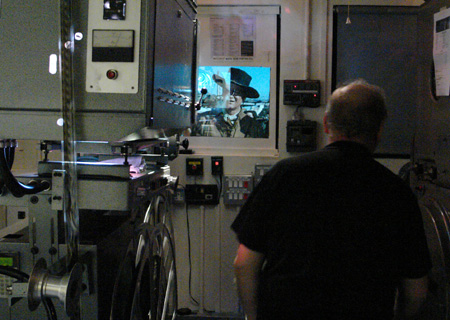 Image
by Tom March Image
by Tom MarchThis was something very special. Having been treated to the original 3-strip Cinemiracle print with completely faded colour and German narration, the audience was treated to a unique premiere on Saturday morning. Regulars Dave Strohmaier and Randy Gitsch from the USA have been remastering „Windjammer“ for presentation in a digital format. Before the film they gave us a lecture which explained in detail what they have done with the original materials during the past several months. To be honest, had they not done the remastering presentation before the film screening, I probably would have thought: “What rubbish are we looking at!” Don’t get me wrong, Dave and Randy did an absolutely marvellous job! It was the first time in many years that we could watch „Windjammer“ in colour! The print was mastered in the Smilebox format especially to fit Pictureville’s Cinerama screen and the original English 7-track sound was remastered by Chace Audio into a Dolby Surround mix for this presentation (a 5.1 or 7.1 mix should be available for it’s Blu-ray and DVD release). Dave and Randy were very precise in saying that they have not restored the movie, but only remastered it digitally and I think that it really should only be regarded as such. In my opinion showing it as a digital cinema presentation only makes sense if the remastering lecture comes with it. I am sure that it will look great on Blu-ray and DVD once it is available. | |
„Alien“ (70mm, 1:2.2, 6-track Dolby Stereo magnetic sound) | |
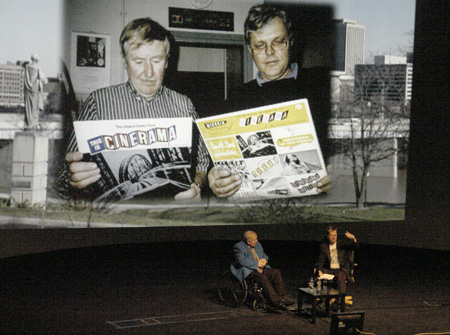 John
Harvey on stage with Larry Smith. Image
by Tom March John
Harvey on stage with Larry Smith. Image
by Tom MarchSince a special retrospective at the 2010 BIFF was dedicated to British actor John Hurt, it was an obvious choice to screen „Alien“ in the 70mm version during Widescreen Weekend. Having not seen this classic for almost 30 years, I was astonished about how well it still serves as a perfect horror movie. I know that a lot of movie goers think that it belongs in the sci-fi genre, but I prefer it to be regarded as a real horror trip. And I can assure you that nobody in the audience fell asleep! Although the print is beginning to fade, it still was nice to watch and offered a marvellous clear and sharp picture. I felt very unhappy for all those patrons who had never seen the film before, for Tony Earnshaw gave the plot away in his introduction speech! | |
„2001: A Space Odyssey“ (70mm, 1:2.2, 6-track Dolby Stereo SR magnetic sound, presented on the curved screen) | |
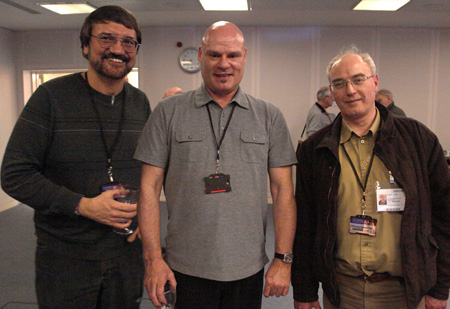 Dave
Strohmaier, Randy Gitsch and Chris O'Kane. Image
by Tom March Dave
Strohmaier, Randy Gitsch and Chris O'Kane. Image
by Tom MarchThe auditorium was really crowded by now. It is obvious that a classic like Stanley Kubrick’s sci-fi master piece still rocks and it proves once and for all that a film like this can only improve by presenting it on the big curved screen in all its 70mm glory. Of course we were going to see the restored version which was done back in 2000, the sound being redone with Dolby SR noise reduction. After a short intro by Sheldon Hall, who told us that back in the 60s a lot of teenagers used „2001: A Space Odyssey“ as the perfect movie to watch while inhaling marihuana(!), the feature started. As soon as the apes appeared on screen making funny noises, I began wondering whether there was something wrong with the sound. It sounded terribly muffled. I instantly had an idea what might have gone wrong. Sitting tight between other patrons in the centre of the cinema I hoped that someone else in the auditorium would realize the problem too and tell Duncan and his team of projectionists. However nobody stood up, so I decided to wait until the first dialogue in the movie is heard. If the problem was still there, I would tell the projectionists. Guess what happened? Yes, I had to ask my patient neighbours to stand up so that I could sneak out of the theatre. I immediately ran into the projection booth, but nobody was there. Suddenly I heard somebody calling my name – it was Duncan who was having a discussion with his colleagues at the adjacent bar. I asked whether the correct set of speakers were activated and they immediately checked it out. I was right – the speakers behind the flat screen which vanished into Pictureville’s ceiling to give way for the big curved screen were activated, instead of those sitting behind the Cinerama screen. One switch and everything was in perfect order again. I decided to wait until the film’s intermission to return, in favour of not troubling the other patrons again. | |
„2010“ (70mm, 1:2.2, 6-track Dolby Stereo magnetic sound) | |
|
Directly after the screening of „2001“ it
was time to screen Peter Hyams‘ sequel to Kubrick’s masterpiece. After
having seen „2001“ (or at least parts of it) on Pictureville’s curved
screen, „2010“ was shown – correctly – on the flat screen. What a
difference this makes! „2010“ wasn’t as impressive as „2001“ and you
could clearly see that it was a mere blow up print. However, the colours
were still intact. | |
„Flying Clipper“ (70mm, 1:2.2, 6-track DTS digital sound, German narration, presented on the curved screen) | |
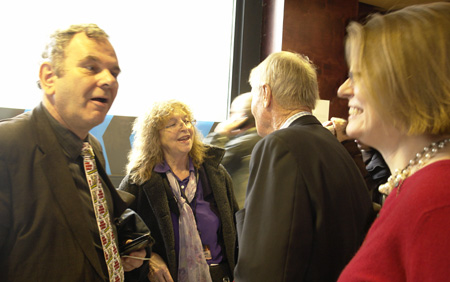 Mark
& Margaret Lyndon talking to Jim Morrison & his daughter. Image
by Tom March Mark
& Margaret Lyndon talking to Jim Morrison & his daughter. Image
by Tom MarchIt seems that this German travelogue was the star of this year’s Widescreen Weekend. It was the only film where the audience also applauded at the film’s intermission! The sharpness and the colours of this brand new print looked marvellous on the big curved screen. Feedback from the audience was really enthusiastic and they all wanted to buy the film on DVD or Blu-ray. However there are no plans for this, although the audio may have already been prepared for such a future release. I had the pleasure of introducing this film and once I had finished, as always walked back to my seat in the centre of the auditorium. I then realized that nothing had happened on screen, as I expected the film’s overture to start as I was walking off the stage. Only after quite some time did it begin. During the intermission I asked Duncan about this. He told me that as soon as he started the projector, he realised that the sound reader was not decoding the signal and the DTS processor needed re-booting! A problem that seems to be quite regular on 70mm DTS screenings in Bradford. It is believed that the huge voltage burst required when striking the xenon lamp can cause the DTS processor to crash – hopefully this problem will be eliminated one day. | |
„The Blue Lagoon“ (70mm, 1:2.2, 6-track magnetic stereo sound) | |
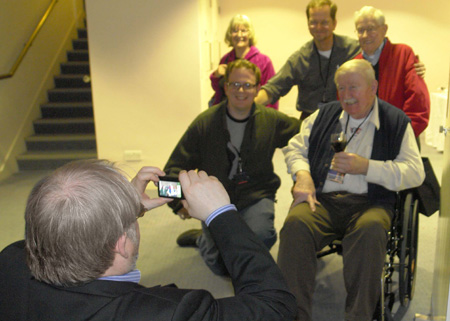 Bill
Lawrence taking images. Image
by Tom March Bill
Lawrence taking images. Image
by Tom MarchI previously only saw this film on a pan-and-scan VHS version, so this 70mm screening (on the flat screen) was definitely an improvement over the home video release and it came along with a nice 6-track mix. Joe Blackwell, who sponsored this screening, did a nice introduction in which he mostly cited from a letter he got from the film’s director Randal Kleiser. Kleiser wanted to attend this screening, but couldn’t get time off his other duties. Watching the film it was remarkable to see how much nudity was in it, especially considering this was an American movie! | |
„Quest for Fire“ (70mm, 1:2.2, 6-track Dolby Stereo magnetic sound) | |
 Paul
Samuels, Randy and Dave, Howard Rust, Brenda and Keith Swadkins. Image
by Tom March Paul
Samuels, Randy and Dave, Howard Rust, Brenda and Keith Swadkins. Image
by Tom MarchNow this was a film I had not seen for almost 30 years! When it came out in Germany I went down by train to Munich where a 70mm print was shown. The print which was shown in Bradford still looked quite good and the sound was nicely mixed. I suspect that this print was made up from two different prints though, because on some reels the changeover sign was elliptical and on the other reels it was round! | |
„The Hunt for Red October“ (70mm, 1:2.2, 7-track Dolby Stereo magnetic sound) | |
 Mike
Taylor and Malcolm Clarke. David Coles in background. Image
by Tom March Mike
Taylor and Malcolm Clarke. David Coles in background. Image
by Tom MarchI must say that the last film of this Widescreen Weekend was also the best sounding one! Unfortunately I still couldn’t follow all of the dialogue in the film (is my English THAT bad?) and therefore was a bit puzzled by the storyline. But this gave me the opportunity to really listen to the film’s marvellous 7-track Dolby Stereo sound. It not only gave Basil Poledouris‘ score the right scope, but also gave the audience the impression of being on board a nuclear submarine. Very impressive, very clear and very loud. And last but not least, all the colours survived. So this film made a perfect ending for the 2010 edition of the Widescreen Weekend. | |
„Cineramacana“ | |
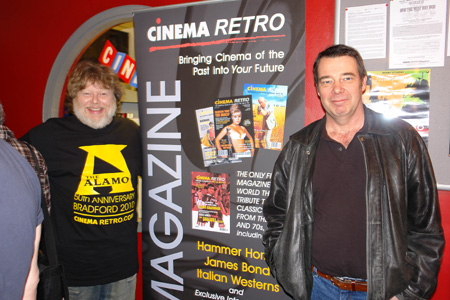 Here
they are again! Lee and Dave from Cinema Retro. Image
by Tom March Here
they are again! Lee and Dave from Cinema Retro. Image
by Tom MarchBeing an old tradition for the Widescreen Weekend, Sundy morning was dedicated to bits and pieces, some provided by members of the audience. As always this was real fun to watch. It started off with a big bang: a 2k digital trailer for the recent Bond movie – „Quantum of Solace“. This looked so brilliant on the flat screen and it sounded very good. Next in line was the traditional quiz. This time the famous kissing montage from Guiseppe Tornatore’s „Cinema Paradiso“ was used and the audience should identify as many movies and actors/actresses as they could. Meanwhile, having seen this film so often I realized that I have never spent any thoughts on the movies from which the kissing clips were taken, so I had to give up very early! May be next time I will get another chance of collecting a prize! Larry Smith was the lucky guy who won first prize: a goodie bag including the „Sharks“ Imax soundtrack CD, a T-shirt and the „West Side Story“ collector's edition DVD including screenplay. The quiz was followed by another tradition: the „In Memorium“ montage. A lot of famous people who were also friends of the museum died recently: Jack Cardiff, Jean Simmons, Ian Carmichael, Ken Annakin and Richard Todd. The montage was cut to “Lara’s Theme” from „Doctor Zhivago“, composed by Maurice Jarre, who sadly also belonged to the artists gone forever. When Bill Lawrence took to the microphone after this screening, you really could tell that he was very moved as he and Jack Cardiff became very close friends over the years. A real big loss. To cheer us all up a bit after this sad interval, the original teaser trailer for „Psycho“ came up. Well, that definitely has nothing to do with widescreen at all, but for me personally, that was the best bit within Cineramacana! I had never before seen it and just loved it! In it Hitchcock moves around the „Psycho“ set in glorious black and white, telling the audience all about the grisly scenes that are to happen here. That is what I call black humour at its very best! The teaser was found by one of the museum’s projectionists inside the booth of a cinema which had no further use of it. Good to know that it now belongs to the National Media Museum’s archive. Ben Wales came up next with a 35mm black and white demo reel from „Raiders of the Lost Ark“, demonstrating how the different layers of sound come together to make a perfect Dolby Stereo soundtrack. I saw this reel many years ago during one of Dolby’s presentations in Munich and it was great seeing it again. Next we were seeing a short scope film in Vistarama called „Aloha Nui“. It was provided by Dave and Randy and was projected using the 1:1.37 aperture plate. Then, young filmmaker Grant Wakefield came up on stage introducing two digital films he provided: the trailer for „Remnants“ and the short subject „Times Littany“. Both were presented in 2k digital with PCM 5.1 sound and both were showcasing time lapse photography made by Grant Wakefield. Grant co-incidentally is the only person who has ever actually supplied new content which is currently being produced and/or made in 1:2.35 format. Arts Alliance Media sponsored and produced the 2k drive. Grant’s films always remind me of „Baraka“ and I am sure that he knows that film! | |
|
After that we were treated to a very unusual clip from the museum’s
vaults: the opening reel of Dario Argento’s „Suspiria“ (still banned in
Germany!) in 35mm CinemaScope and 4-track magnetic stereo sound. What an
impressive sound mix that was! I think that the complete film should be
included in a forthcoming festival. The next clip was provided by Ben
Wales again - this time he went for a 70mm clip of „Bolshoi Ballet“.
Well, not my type of film, but nice to see in the 70mm format. Then the
projection team had to switch to the curved screen. While this was done
we were treated to the overture from „Goodbye Mr. Chips“ running off a
70mm blank print with 6-track magnetic stereo sound. Once the curved
screen was ready to go, two 70mm ride films came up which were donated
by Chris O’Kane (who gave a short update on his Vistamorph process) to
the museum’s archive. This was followed by a picture only 70mm clip from
„Cheyenne Autumn“, which was faded, but still showed off real good
quality. Its soundtrack obviously was replaced by all sorts of sound
alignment tones. Before the Academy of the Widescreen Weekend assembled
on stage to welcome John Harvey as a new member to the club, Dave Strohmaier provided what he calls a „Thrill Reel“. This was a 14 minute
3-strip Cinerama demonstation film made up from various Cinerama films
like „This is Cinerama!“ and „How the West was won“. This was absolutely
stunning and my stomach began to rebel when the camera was taken up on a
merry-go-round! | |
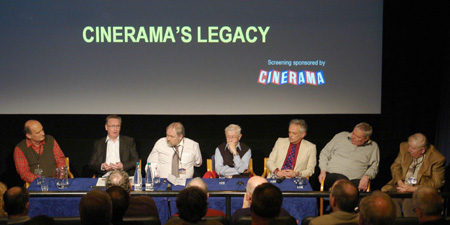 Image
by Tom March Image
by Tom MarchWell, didn’t we miss one tiny little thing? Oh yes – we missed the traditional Audience on Stage picture! Sadly Thomas Hauerslev could not attend the weekend this time and so nobody seemed to be prepared for taking the annual photograph! Later, Duncan told me they were all set to do it, but ran into severe timing problems with Cineramacana over running and therefore had to drop it at the last minute. Well, next time I hope everything will be back on schedule as usual. In between the screenings there was another lecture which I quite enjoyed. David Coles came all the way from Australia to tell the whole truth about Oyster Bay. That is the location in the USA where it all started with Cinerama. David’s powerpoint presentation had so many facts about this area that it took almost a whole hour to get through everything. The good thing was that he has a very funny way of telling things and I really liked this guy’s sense of humor. It was a very entertaining lecture! As always I was able to meet a lot of friends during the many intermissions as well as the delegate‘s reception. It is always such great fun chatting about our favourite subject – movies and widescreen. Even Johan Wolthuis came over for just one day to present his latest publication on the subject of Digital and 65mm. Of course I bought my copy and wished him a lot of luck with this project. | |
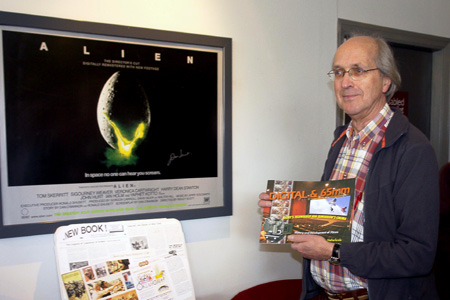 Johan
Wolthuis - unstoppable promoting 70mm. Image
by Tom March Johan
Wolthuis - unstoppable promoting 70mm. Image
by Tom MarchFor me in particular there was another highlight which I should mention. Since the Bradford International Film Festival, of which the Widescreen Weekend is a part of, was reduced in length to give a more focused dynamic to the overall festival, the Pictureville theatre was reserved for the festival’s closing night ceremony. This meant that all widescreeners had either to watch „Alice in Wonderland“ in the IMAX auditorium or listen to “Cinerama’s Legacy” in the Cubby Broccoli theatre. Having already seen Tim Burton’s „Alice in Wonderland“ in IMAX 3D on the day of my arrival in Bradford, I decided to go for something completely different: watching the closing film of the festival! Now that certainly had nothing to do with widescreen at all, but it starred my heroine from the seventies: Jenny Agutter. The film in question was „The Railway Children“ and it was going to be screened in a restored 2k digital version with three members of the cast attending. Oh yes – lovely Jenny was one of them! This was definitely something I couldn’t resist attending. While I was waiting for the auditorium to open, my dear friend Francois approached me and asked what I was waiting for, so I explained. You should have seen the expression on Francois‘ face when he said to me “But this is not even widescreen!” “Well Francois, you see there are more things in life than just widescreen!” I replied, with a smile on my face. | |
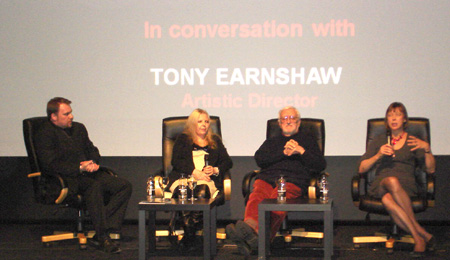 Left
to right: Tony Earnshaw, Sally Thomsett, Bernard Cribbins and Jenny
Agutter. Image
by Wolfram Hannemann Left
to right: Tony Earnshaw, Sally Thomsett, Bernard Cribbins and Jenny
Agutter. Image
by Wolfram Hannemann„The Railway Children“ was completely sold out and everybody in the audience seemed to know this English classic by heart. Before the film started Tony Earnshaw did a screen talk with guests Bernard Cribbins, Sally Thomsett and Jenny Agutter, which was very interesting. I was most impressed when Jenny suddenly referred to the film’s composer and his lovely score for the film! Unfortunately the cast had to leave before the film started, due to their other duties. I really enjoyed watching the film and judging by the audience’s reaction, everybody felt the same. The picture quality of the 2k digital print was really stunning. After the film finished, I was suddenly approached by one of the guys sitting next to me during the Widescreen Weekend. He also decided to go for this special event. If Francois could only have known...! By the way: I was told afterwards that „Cinerama’s Legacy“ was a huge success with all those attending the session. Hopefully some readers who actually attended this lecture could let us know a bit about it? Well, Francois, that’s your turn! | |
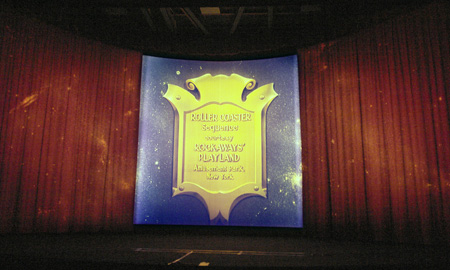 "The
End". Image
by Tom March "The
End". Image
by Tom MarchAs always I felt a bit exhausted after such a lengthy time inside a cinema, having seen so many movies and meeting a lot of friends. Since my flight back to Germany was not until Tuesday evening, I suggested to Duncan that we partake of a nice Indian dinner on Monday evening, followed by English beer tasting afterwards in the pub. Of course Duncan willingly accepted – he really needed some rest after the festival! As always, we discussed some interesting ideas for the next Widescreen Weekend while enjoying our pints. I am already looking forward to it and I know for sure that Duncan has already begun planning it! Right at the end of my story I would like to point out something which worries me a little bit. When I saw „The Taming of the Shrew“ on Pictureville’s flat screen in a 70mm presentation last year, I wondered why the opening credits were severly cut on both left and right edges. Back then Duncan told me he believed it was already printed that way on the 70mm blow up print. I had no reason for not believing this, keeping in mind that „Taming“ most probably was a one off print and nobody ever thought about the safe area. This year however, I noticed the same thing on the 70mm print of „Alien“, which also was projected on to the flat screen. Again there were cut-offs at the left and right edges during the opening credits. Not that this effect spoiled the overall experience, but I am beginning to believe there could be another problem involved. Hopefully Duncan will check this out soon – I am sure that he will be able to eliminate the problem. That is what professionals are for, arent’t they? (Note: My sincere thanks goes to Duncan McGregor for proof reading my story) | |
| Go: back - top - back issues - news index Updated 22-01-2025 |
